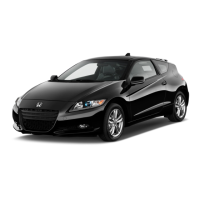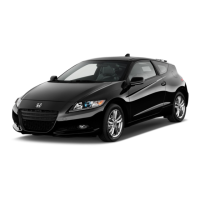
Do you have a question about the Honda CR-Z 2016 and is the answer not in the manual?
| Brand | Honda |
|---|---|
| Model | CR-Z 2016 |
| Category | Automobile |
| Language | English |
Details on vehicle systems emitting radio waves and FCC/Industry Canada compliance.
Explanation of the vehicle's event data recorder (EDR) and the data it collects.
Information regarding perchlorate materials in vehicle safety components.
Warning about chemicals in the product known to cause cancer or birth defects.
Information on service-related devices recording powertrain performance data.
Contact information and procedures for seeking assistance from Honda customer service.
Details on 24-hour emergency road service available in the U.S. and Canada.
Identifies buttons and controls on the steering wheel and surrounding areas.
General guidance on vehicle safety features and their use.
Key precautions for safe driving, including seat belts and speed control.
Explanation of DANGER, WARNING, CAUTION, and NOTICE messages used in the guide.
Hazards and precautions related to carbon monoxide emissions.
Proper use, inspection, and fastening of seat belts for occupant safety.
How to regularly check the condition and functionality of seat belts.
Step-by-step instructions for properly fastening the lap and shoulder seat belts.
Details on front, side, and curtain airbags, indicators, and components.
Explanation of front airbags, their purpose, and advanced features.
Information on advanced airbag systems, including seat position and weight sensors.
Details on side airbags protecting the torso during side impacts.
Information on side curtain airbags protecting the head during side impacts.
Explanation of the SRS indicator light and its meaning.
Indicator explaining when the front passenger airbag is deactivated.
Indicator explaining when the side airbag is deactivated.
Diagram and explanation of the various airbag system components.
Key guidelines for airbag safety, including seating and object placement.
Instructions for when airbag system components may need inspection by a dealer.
Recommendations and precautions for restraining children in the vehicle.
Precautions for restraining infants, especially regarding rear-facing seats.
Guidance for restraining children in forward-facing child seats.
Considerations for choosing the correct type and size of child seat.
Step-by-step guide to installing a child seat using the vehicle's seat belt.
Instructions for installing a child seat using the tether anchorage point.
Guidelines for seating larger children and proper seat belt use.
Diagrams showing the locations of safety labels on the vehicle.
Procedures for reporting vehicle safety defects to authorities.
Explains critical warning lights indicating vehicle system problems.
Indicator for high engine coolant temperature and overheating precautions.
Indicator for low engine coolant temperature and potential sensor issues.
Explains indicators that require driver action or attention.
Explains indicators that show when a system is active or inactive.
Displays the remaining charge level of the IMA hybrid battery.
Shows the degree of electric motor assistance to the engine.
Indicates the degree to which the IMA battery is being charged.
Details on accessing and customizing vehicle information via the display.
Personalizing vehicle settings through the multi-information display and steering wheel.
Operating the remote transmitter to lock/unlock doors and hatch.
Using the keyless entry system with the remote transmitter.
Methods for locking, unlocking, and opening vehicle doors.
How to operate and lock the vehicle's power windows.
Using the turn signal lever for quick lane changes.
Controls for interior lighting and exterior lights, including headlights.
How to use front and rear wipers and washers, and maintenance tips.
Proper adjustment of driver and passenger seats for comfort and safety.
Proper positioning and anchoring of floor mats to ensure safety.
Information on head restraint function, removal, and reinstallation.
Accessing and using the rear cargo console and folding the separator.
Extending, retracting, removing, and storing the cargo cover.
Adjusting rearview and power door mirrors for optimal visibility.
Tilting and telescoping the steering wheel for a comfortable driving position.
Operating the automatic climate control for interior temperature.
Using the seat heater functions for quick warming.
Adjusting the vehicle's clock time via the touchscreen.
Personalizing vehicle settings through the touchscreen menu.
Connecting audio devices like USB drives, iPods, and HDMI.
Details on connecting USB flash drives and other audio devices.
Using the 12V power socket for accessories.
Connecting devices to play video via the HDMI port.
Using steering wheel buttons to control the audio system functions.
Modifying sound settings like bass, treble, and balance.
Navigating and interacting with the vehicle's touchscreen interface.
Customizing the order of icons on the HOME screen.
Integrating a smartphone with the audio system for app access.
Tuning, scanning, and using presets for radio stations.
Playing audio CDs, including MP3, WMA, and AAC formats.
Connecting and playing music from an iPod via USB.
Connecting and playing music from a USB flash drive.
Streaming audio from a compatible phone via Bluetooth.
Using the Pandora app through the vehicle's audio system.
Making and receiving calls using the vehicle's hands-free system.
Explains the buttons used for operating the HFL system.
Guidance for using voice commands with the Talk button.
Steps to pair a mobile phone with the vehicle's Bluetooth system.
Methods for initiating phone calls using voice or touchscreen.
Features for emergency assistance via the HondaLink system.
Receiving and sending text messages and emails via the phone.
Activating and using Siri voice assistant with an iPhone.
Overview of the GPS navigation system and its functions.
Using steering wheel buttons to control the navigation system.
Explains the touchscreen interface for map and navigation options.
Adjusting the volume for navigation voice prompts and confirmations.
Turning the voice feedback feature for navigation on or off.
Tips for using voice commands with the navigation system.
Methods for inputting destinations into the navigation system.
Entering destinations by category and specific place name.
Locating nearby points of interest by category.
Managing routes, including map legends and guidance.
Calculating a detour route to avoid road closures or congestion.
Viewing traffic information and routing around incidents.
Procedures for canceling an active navigation route.
Checks to perform before starting the vehicle, both exterior and interior.
Ensuring windows, lights, and hood are clear and secure before driving.
Securing items, adjusting seating, and ensuring seat belts are fastened.
Guidelines for vehicle loading to ensure safety and stability.
Procedures for starting the engine and beginning to drive.
Checks before starting the engine for CVT and manual transmissions.
Operating the ENGINE START/STOP button to select power modes.
Operating the shift lever for CVT and manual transmissions.
Using paddle shifters to manually change gears in the CVT.
Operating the clutch and shift lever for manual transmission.
Information on foot brake, brake assist, ABS, and parking brake.
Selecting and understanding SPORT, NORMAL, and ECON driving modes.
Using the Plus Sport system for momentary acceleration assist.
How to improve fuel economy using the Eco Assist system.
Monitoring engine and electric motor power flow.
Real-time display of fuel efficiency and driving style score.
Functionality and operation of the automatic engine idle stop system.
How VSA/ESC helps maintain stability and traction.
Activating, setting, and adjusting vehicle speed with cruise control.
Using the LaneWatch system to monitor blind spots.
Using the rear camera display and parking guidelines.
Enabling/disabling fixed and dynamic guidelines for the rear camera.
Proper fuel types and procedures for refueling the vehicle.
Recommended fuel types and additives for optimal performance.
Step-by-step instructions for safely refueling the vehicle.
Procedure to start the engine if the remote battery is weak.
Steps to release the shift lever if it's stuck in Park.
How to safely jump-start the vehicle's battery.
Steps for safely disconnecting jumper cables after starting the engine.
Actions to take if the engine overheats, including safe stopping procedures.
How to safely stop the engine in an emergency while driving.
Information and warnings regarding towing the vehicle.
Functionality and calibration of the TPMS for tire pressure monitoring.
Federal requirements and explanations for the TPMS system.
Using the temporary tire repair kit for minor punctures.
Identifying interior and engine compartment fuse box locations and circuit protection.
Diagrams and lists of fuses located in the interior fuse boxes.
Procedures for checking and replacing blown fuses.
General safety guidelines for performing vehicle maintenance.
Safety tips for working on the vehicle, including battery and fuel precautions.
Understanding and responding to the vehicle's maintenance alerts.
Codes indicating required maintenance items and services.
Locating and checking engine oil, coolant, and other components.
Steps for safely opening and securing the vehicle's hood.
Checking engine oil level and recommended oil types.
Details on Honda Genuine Motor Oil and API certification.
Correct procedure for adding engine oil and avoiding overfilling.
How to reset the engine oil life indicator after service.
Checking and adding engine coolant to the reserve tank and radiator.
Checking brake fluid level and recommended fluid types.
Checking and refilling the windshield washer fluid reservoir.
Inspecting the battery terminals and condition for corrosion.
Procedures for replacing front and rear wiper blades.
Steps to replace the rubber inserts on the front wiper blades.
Steps to replace the rubber insert on the rear wiper blade.
Guidelines for tire type, size, inflation, inspection, and wear indicators.
Understanding the tire and loading information label on the doorjamb.
Recommendations for replacing tires and wheels correctly.
Factors affecting tire lifespan and recommended replacement intervals.
Recommendations for using winter tires and tire chains.
Understanding markings and codes on tire sidewalls.
Explanation of the Tire Identification Number (TIN) markings.
Definitions of common tire-related terms like load rating and pressure.
Explains tire grading for treadwear, traction, and temperature.
Understanding tire temperature grades and their implications.
Specifications for all exterior and interior light bulbs used in the vehicle.
Engine displacement, coolant, fluids, spark plugs, fuel type, and tank capacity.
Tire sizes and recommended inflation pressures for front and rear.
Common questions and answers about vehicle operation and issues.
Information on how to contact Honda customer service for assistance.
Contact details for Honda's U.S. customer service center.
Contact details for Honda Canada's customer relations department.
Details on 24-hour emergency roadside assistance services.
Summary of new vehicle limited, emissions, and other warranties.
Commands accepted by the system on any screen for general functions.
Commands for controlling the navigation system and displaying map information.
Basic voice commands for system interaction and information display.
Voice commands for controlling map views and display options.
Voice commands to find specific places or types of locations.
Voice commands for managing navigation routes and guidance.
Voice commands for operating the vehicle's climate control system.
Voice commands for controlling the audio system, radio, and media playback.
Using voice commands for searching and playing music from iPod/USB.
Voice commands for controlling the Pandora music streaming app.
Voice commands for managing Bluetooth audio playback.
Voice commands for making calls and managing phone contacts.
Voice commands for accessing trip computer and traffic information.
On-screen voice commands accepted by the system for navigation.












